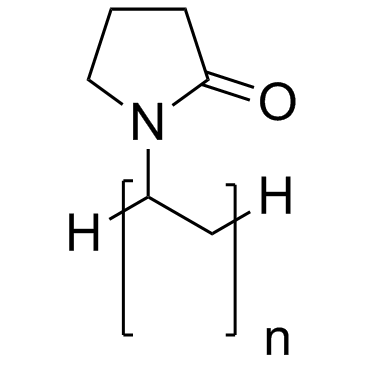9003-39-8
| Name | poly(vinylpyrrolidone) |
|---|---|
| Synonyms |
k60
Polyvinylpyrrolidone PVP Kollidon K25 Kollidon K-90 k25 MFCD00149016 POP Kollidon 25 k115 pvp2 pvp3 K-30 pvp4 PVPD |
| Description | Polyvinylpyrrolidone is a compound which has been widely tested and used in human and veterinary medicine as an effective wound healing accelerator and disinfectant when combined with iodine and other compounds. |
|---|---|
| Related Catalog | |
| In Vivo | Goldfishes which are treated with salt have significantly lower mucus weights at 25 h. Goldfishes treated with Polyvinylpyrrolidone (PVP) have significantly higher mucus weights at 25 h. Koi treated with salt and Polyvinylpyrrolidone (PVP) has significantly lower mucus weight at 1 and 25 h. Control koi has significantly higher mucus at 25 h. At the end of 2 weeks, it is determined that the three koi treated with salt and Polyvinylpyrrolidone(PVP) remain healthy and show a higher degree of healing than other treatment koi and the control group[1]. |
| Animal Admin | Each fish within a tank serves as a replicate. Treatments are designated as Polyvinylpyrrolidone (at a dose of 10 mL/10 gallon) and saline/salt at 3g/L. A control group that does not receive any chemical is also included in the study. All fishes from each treatment group are sampled at 0 min, 15 min, 1 h, 4 h and 25 h. At each time interval, all fishes from each treatment group are anaesthetized using buffered tricaine methanesulfonate, weighed, and slime is scraped from one 1 cm2 area over the epaxial musculature using a preweighed plastic coverslip[1]. |
| References |
| Density | 1.144g/cm3 |
|---|---|
| Boiling Point | 217.6ºC at 760 mmHg |
| Melting Point | 130ºC |
| Molecular Formula | (C6H9NO)n |
| Molecular Weight | 111.1418 (monomer) |
| Flash Point | 93.9ºC |
| PSA | 20.31000 |
| LogP | 0.69020 |
| Storage condition | Store at RT. |
| Water Solubility | H2O: soluble100mg/mL |
CHEMICAL IDENTIFICATION
HEALTH HAZARD DATAACUTE TOXICITY DATA
|
| Personal Protective Equipment | Eyeshields;Gloves;type N95 (US);type P1 (EN143) respirator filter |
|---|---|
| Hazard Codes | Xn |
| Safety Phrases | S24/25 |
| RIDADR | NONH for all modes of transport |
| WGK Germany | 1 |
| RTECS | TR8370000 |
| HS Code | 3905990000 |
|
~% 
9003-39-8 |
| Literature: US2006/216263 A1, ; Page/Page column 5-6 ; |
| Precursor 1 | |
|---|---|
| DownStream 0 | |
| HS Code | 3905990000 |
|---|

